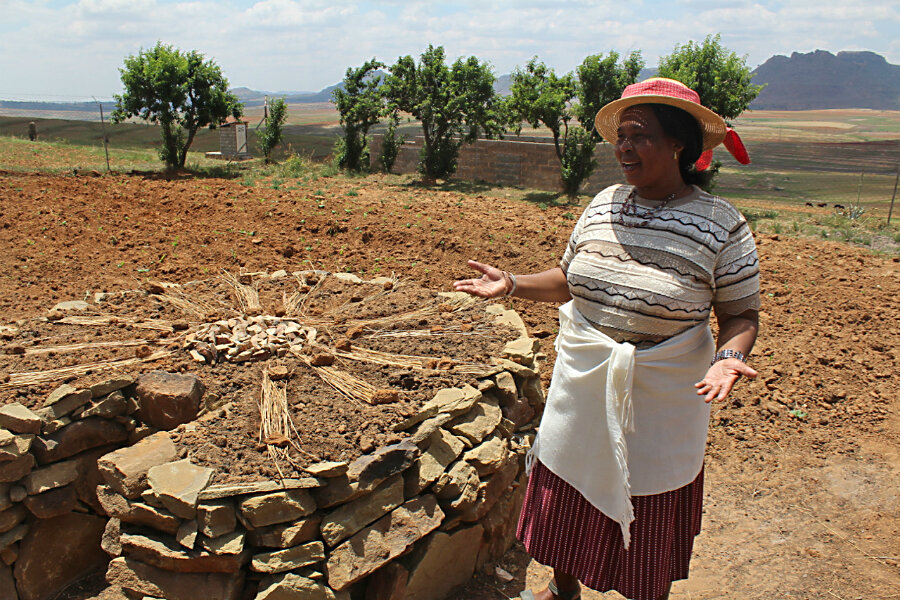Why drought-resistant farming could be a feminist act in Lesotho
Loading...
| HA PHALOLE, LESOTHO
Maleloko Fokotsale’s garden isn’t very photogenic. From a distance, it looks like little more than a jumble of rocks and dirt piled high beside her neat fields in the rolling hills outside Lesotho’s capital.
And it wasn’t easy to build – there were stones to be hauled and trenches dug, dirt and leaves and fertilizer to be layered delicately like sections of a parfait.
However, this “keyhole” garden – so named for its unusual shape, like the body of an open-mouthed pac man – has a crucial advantage over the fields that surround it. It uses far less water to produce a given quantity of vegetables, helping subsistence farmers here to weather one of the worst droughts of the past century, which is now barreling toward its third year across southern and eastern Africa.
But for farmers like Ms. Fokotsale – also the chief of this small village – building a drought resistant garden gave her another, less obvious benefit, too.
Time.
Like most women here, hours of Fokotsale’s days are peeled away collecting her family’s water – wheelbarrows full of it – from nearby streams and wells. So for her, making farming more resistant to drought isn’t only a way to grow more in a parched season – it eases her domestic burdens. And that’s an effect that’s likely to continue long after this drought passes.
A shifting climate
That logic could have applications far beyond tiny Lesotho. Across the developing world, climate change and the extreme weather it brings are forcing farmers to innovate, potentially dislodging not only old ways of farming, but old ways of thinking as well. And few stand to benefit as much from those changes as women.
“Women are extremely vulnerable to a changing climate,” says Mary Nyasimi, a Nairobi-based gender and policy scientist at the CGIAR Research Program on Climate Change, Agriculture and Food Security, because they are the ones responsible for environment-linked tasks like gathering firewood, growing food for their families, and collecting water. “When your livelihood and survival depends so much on natural resources, you become really sensitive to the effects of extreme weather.”
The current drought in southern Africa, which has withered the region with dry weather, parched rivers, and widespread crop failure, is linked to the El Niño weather pattern – a cyclical warming of the Pacific Ocean that flip-flops weather in much of the world every three to five years. Though those shifts are natural, some climate scientists say they appear to be growing more extreme as a result of human-caused climate change. The recent El Niño is one of the strongest ever recorded, and scientists say that rising greenhouse gas emissions are likely to make such mega El Niños more common.
By the end of the century, in fact, they will probably occur twice as often as they do now, according to a 2015 Nature article. Africa – the world’s poorest and most ecologically fragile continent – is likely to bear that burden disproportionately.
That is why, in countries like Lesotho – where a quarter of the population is currently in need of food aid as a result of the drought – organizations like the Food and Agriculture Organization of the United Nations (FAO) are stepping up efforts to train farmers in growing techniques better able to withstand extreme weather.
The 'keyhole garden'
Keyhole gardens like Fokotsale’s are part of that strategy. First developed in Lesotho in the 1990s, they consist of a central compost well surrounded by a walled-in garden. When water is added to the compost well, nutrients seep into the soil around it, fertilizing crops.
Originally thought up to make food cultivation easier for people diagnosed with HIV – since the gardens require little labor to keep going – the gardens also require as much as 70 percent less water than normal farming, according to some keyhole garden developers, and can use “gray water” recycled from washing or bathing, making them ideal for times of drought.
And just as the burdens of collecting water fall disproportionately on women, FAO officials here discovered that the benefits of reducing the water needed for growing crops do, too.
“If access to water [during droughts] is a challenge, it’s also a gendered challenge, because it’s women who collect it,” says Borja Miguelez, emergency coordinator for the FAO in Lesotho. “Caring for a home garden is predominantly a female activity, so making that easier and more productive can be a big improvement in the lives of women.”
Fokotsale, for her part, wouldn’t say her garden has revolutionized her life. But it has allowed her to cut back on one of her most arduous chores – walking a mile each direction to the nearest water source, on the way back carting two full 30-liter (8 gallon) jugs.
“To carry all that water, you must be very strong,” Fokotsale says. “Sometimes the men help, but not usually. So for us women, it is better to garden like this, using only small, small water.”
Ryan Lenora Brown traveled to Lesotho with UNICEF.








